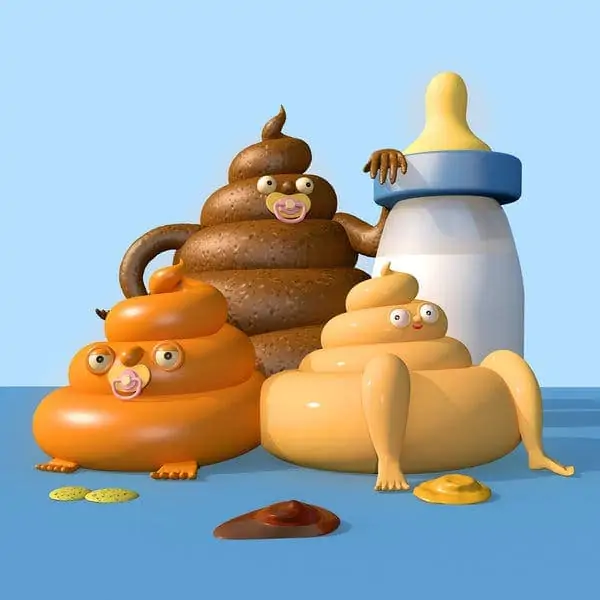Baby poop goes through a variety of changes as they grow, drink breast milk or formula and start solid foods. It’s important to pay attention to what’s in baby’s diaper because the color and consistency can tell you a lot about baby’s health. Green poop, yellow or brown – let’s examine what each means.
Types of Baby Poop
Newborn Baby Poop: After birth, a baby’s first bowel movements are black, tarry and sticky. This type of stool is known as meconium and is made up of amniotic fluid, mucus, skin cells and other things ingested during pregnancy. Two to four days after birth, you should see a transition to a green poop that is less tacky than meconium.
Breastfed Baby Poop: As baby begins digesting breast milk, meconium is replaced with a mustard yellow, green or brown color stool. It is typically seedy and pasty in texture and may be runny enough to resemble diarrhea. Healthy breastfed stools will smell sweet (unlike regular bowel-movement odor).
Formula-Fed Baby Stools: When you start formula, healthy poop is typically a shade of yellow or brown with a pasty consistency that is no firmer than peanut butter. Formula-fed babies also pass fewer, but bigger and more smelly stools than breastfed babies.
Partially Digested Food in Bowel Movements: Some foods travel so quickly through the intestines that they don’t break down completely and this can cause chunks of food to appear in your baby’s stool or for it to have a surprising color.
Guide for Baby Poop by Color
Green Baby Poop: Babies taking an iron-supplement will often have green baby poop. Green baby poop can also occur at 4 to 6 months when they start eating solid, green foods, such as pureed peas, spinach and beans.
Orange, Yellow and Brown Stools: These colors are normal in breastfed and bottle fed babies.
Black Blood in Baby Poop: If baby’s stool has little specks of black blood in it, it means baby has digested blood while breastfeeding on mother’s cracked and bleeding nipples. This does not pose a threat to your baby, but it’s a good idea to check with a doctor to make sure the blood is not a symptom of something more serious.
Once your baby begins eating solid food, his or her bowel movements might contain a wide variety of colors.
Poop Warning Signs
If you’re concerned about the color or consistency of your baby’s bowel movements, contact your baby’s doctor. This is especially important if your baby’s bowel movements are:
Runny or Watery: Baby’s diarrhea will be green, yellow or brown and runny. It can be an indication of an infection or allergy. It can cause dehydration if it goes too long without treatment.
Hard, Pebble-like: Babies can become constipated when they are introduced to solid foods. Pebbly stools could also be a sign of sensitivity to milk or soy, or a intolerance to something in breast milk or formula.
Red or Bloody: While baby’s poop can turn red because of something they ate or drank, such as tomatoes or fruit punch, red baby poop can be a sign of blood in the stool. Red blood found in normal poop could be a sign of a milk protein allergy, while red blood in diarrhea could mean your baby has a bacterial infection.
Mucus: Slimy, green-colored streaks with glistening strings in your baby’s poop means mucus is present. Although it can happen when your baby is drooling, mucus in baby poop can also be a sign of infection.
White: Chalky white baby poop could be a warning sign that your baby is not properly digesting food. A white color may indicate a lack of bile from the liver to digest food.
Your baby will have a full range of “normal” baby poop types that simply indicate your baby is healthy and growing. Contact your doctor if you see any of these warning signs and be prepared to describe your baby’s bowel movements, including color, consistency, volume and frequency. The more details you provide, the better the doctor will be able to help you determine what’s normal for your baby and when treatment might be needed.
Sources:






